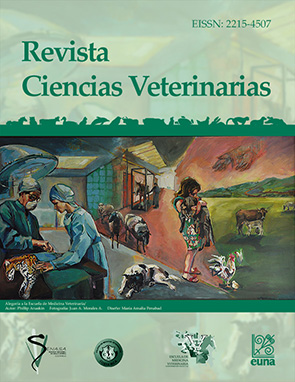Diagnóstico del Virus de la Celda Real Negra, el Virus de Alas Deformes y el Virus de la Parálisis Aguda en abejas africanizadas (Apis mellifera scutellata), sintomáticas de Costa Rica, utilizando RT‐PCR en tiempo real.
DOI:
https://doi.org/10.15359/rcv.34-1.1Palabras clave:
Abejas Apis mellifera scutellata, RT-PCR tiempo real, SYBR Green, DWV, BQCV, ABPV, Costa RicaResumen
Tras denuncias de apicultores, por la presencia de abejas Apis mellifera scutellata enfermas en colmenas localizadas en la región central sur de la provincia de San José, Costa Rica, se recolectó muestras de abejas adultas vivas, con sintomatología presuntiva de infección viral. Las muestras fueron extraídas y procesadas en el laboratorio. A partir de estas muestras, se diagnosticó, por primera vez en Costa Rica, la presencia del virus de la Celda Real Negra (BQCV) y el virus de la Parálisis Aguda (ABPV), en los cantones de: Turrubares, distrito San Pedro; Tarrazú, distrito San Marcos, respectivamente. Además, se confirmó, por PCR, la presencia del virus de las Alas Deformes (DWV) en el país. La información, acerca de las enfermedades virales en Costa Rica, es todavía escasa, por lo cual, la implementación de estas metodologías abre la posibilidad de ofrecer, a los apicultores de este país, un diagnóstico rápido, específico y sensible. La puesta a punto de estas técnicas, además, podría ser el inicio para la realización de investigaciones con el fin de determinar la prevalencia de virus en las colmenas costarricenses, así como posibles factores de riesgo asociados a estas infecciones.Referencias
Alippi, A.M. 1992. Detección de Bacillus larvae en poblaciones mixtas de esporas bacterianas a partir de restos larvales. Microbiología 8: 115–118
Allen, M. & Ball, B. 1996. The incidence and world distribution of honey bee. Bee World 77: 141–162. DOI: http://dx.doi.org/10.1080/0005772X.1996.11099306.
Anderson, D.L. & Gibbs, A.J. 1988. Inapparent Virus Infections and their Interactions in Pupae of the Honey Bee (Apis mellifera Linnaeus) in Australia. J. Gen. Virol. 69: 1617–1625. DOI:http://dx.doi.org/10.1080/0005772X.1996.11099306.
Azzami, K., Ritter, W., Tautz, J. & Beier, H. 2012. Infection of honey bees with acute bee paralysis virus does not trigger humoral or cellular immune responses. Arch. Virol.157: 689–702. DOI: http://dx.doi.org/10.1007/s00705-012-1223-0.
Bailey, L. & Ball, B. 1991. Honey bee pathology. Academic Press., London.
Bailey, L. & Woods, R. 1977. Two More Small R N A Viruses from Honey Bees and Further Observations on Sacbrood and Acute Bee-Paralysis Viruses. J. Gen. ViroL 37: 175–182. DOI: http://dx.doi.org/10.1099/0022-1317-37-1-175.
Bakonyi, T., Grabensteiner, E., Kolodziejek, J., Rusvai, M., Topolska, G., Ritter, W. & Nowotny, N. 2002. Phylogenetic Analysis of Acute Bee Paralysis Virus Strains Phylogenetic Analysis of Acute Bee Paralysis Virus Strains. Appl. Environ. Microbiol. 68(12): 6446-50. DOI: http://dx.doi.org/10.1128/AEM.68.12.6446-6450.2002.
Ball, B. V & Bailey, B. 1997. No Title, p. 13–31. In R. Morse, K. Flottum & A.I. Root (eds.). Honey Bee Pests, Predators and Diseases. Ohio, USA.
Ball, B. V. & Allen, M.F. 1988. The prevalence of pathogens in honey bee (Apis mellifera) colonies infested with the parasitic mite Varroa jacobsoni. Ann. Appl. Biol. 113: 237–244. DOI: http://dx.doi.org/10.1111/j.1744-7348.1988.tb03300.x.
Ball, B.1997. Varroa and viruses, p. 11–15. In Varroa Fight the Mite. International Bee Research Association, Cardiff.
Békési, L., Ball, B. V, Dobos-Kovács, M., Bakonyi, T. & Rusvai, M. 1999. Occurrence of acute paralysis virus of the honey bee (Apis mellifera) in a Hungarian apiary infested with the parasitic mite Varroa jacobsoni. Acta Vet. Hung. 47: 319–24. DOI: http://dx.doi.org/10.1556/AVet.47.1999.3.5.
Bowen-Walker, P., Martin, S. & Gunn, A. 1999. The transmission of deformed wing virus between honeybees (Apis mellifera L.) by the ectoparasitic mite varroa jacobsoni Oud. J. Invertebr. Pathol. 73: 101–6. DOI: http://dx.doi.org/10.1006/jipa.1998.4807.
Calderón, R., Van Veen, J., Arce, H.G. & Esquivel, M.E. 2003. Presence of deformed wing virus and Kashmir bee virus in Africanized honey bee colonies in Costa Rica infested with Varroa destructor. Bee world 84: 112–116. DOI: http://dx.doi.org/10.1080/0005772X.2003.11099586.
Chen, Y., Zhao, Y., Hammond, J., Hsu, H., Evans, J. & Feldlaufer, M. 2004. Multiple virus infections in the honey bee and genome divergence of honey bee viruses. J. Invertebr. Pathol. 87: 84–93. DOI: http://dx.doi.org/10.1016/j.jip.2004.07.005.
Chen, Y.P. & Siede, R. 2007. Honey bee viruses. Adv. Virus Res. 70: 33–80. DOI: http://dx.doi.org/10.1016/S0065-3527(07)70002-7.
Cordoni, G. 2011. Epidemiology and Taxonomy of Honey Bee Viruses in England and Wales. University of Surrey.
Dall, D. 1985. Inapparent infection of honey bee pupae by Kashmir and sacbrood bee viruses in Australia. Ann. Appl. Biol. 106: 461–468. DOI: http://dx.doi.org/10.1111/j.1744-7348.1985.tb03136.x
Faucon, J.P., Vitu, C., Russo, P. & Vignoni, M. 1992. Diagnostic de la paralysie aiguë application à l’épidémiologie des maladies virales de l’abeille en France en 1990. Apidologie 23: 139–146. DOI: http://dx.doi.org/10.1051/apido:19920206
Gauthier, L., Tentcheva, D., Tournaire, M., Laurent, G., Diana, T., Magali, T., Benjamin, D., François, C., C, M.E. & Max, B. 2007. Viral load estimation in asymptomatic honey bee colonies using the quantitative RT-PCR technique. Apidologie 38: 426–435. DOI: http://dx.doi.org/10.1051/apido:2007026.
Genersch, E., Von Der Ohe, W., Kaatz, H., Schroeder, A., Otten, C., Büchler, R., Berg, S., Ritter, W., Muhlen, W., Gisder, S., Meixner, M., Liebig, G., Rosenkranz, P., 2010. The German bee monitoring project: a long term study to understand periodically high winter losses of honey bee colonies. Apidologie 41, 332-352. DOI: http://dx.doi.org/10.1051/apido/2010014.
Hall, T.A. 1999. BioEdit: a user-friendly biological sequence alignment editor and analysis program for Windows 95/98/NT. Nucl. Acids. Symp. 41: 95–98.
Higes, M., Martín-Hernández, R. & Meana, A. 2010. Nosema ceranae in Europe: an emergent type C nosemosis. Apidologie 41: 375–392. DOI http://dx.doi.org/10.1051/apido/2010019.
Hung, A.C.F., Shimanuki, H. & Knox, D.A. 1996. Inapparent infection of acute bee paralysis virus and Kashmir bee virus in the U.S. honey bees. Am. Bee J. 1: 874–876.
Kukielka, D., Esperón, F., Higes, M. & Sánchez-Vizcaíno, J.M. 2008. A sensitive one-step realtime RT-PCR method for detection of deformed wing virus and black queen cell virus in honeybee Apis mellifera. J. Virol. Methods 147: 275–81. DOI: http://dx.doi.org/10.1016/j.jviromet.2007.09.008.
Kukielka, D. & Sánchez-Vizcaíno, J.M. 2009. One-step real-time quantitative PCR assays for the detection and field study of Sacbrood honeybee and Acute bee paralysis viruses. J. Virol. Methods 161: 240–6. DOI: http://dx.doi.org/10.1016/j.jviromet.2009.06.014.
Martin, S. 2001. The role of Varroa and viral pathogens in the collapse of honeybee colonies: a modelling approach. J. Appl. Ecol. 53 105–112. DOI: http://dx.doi.org/10.1046/j.1365-2664.2001.00662.x.
Nordström, S. 2003. Distribution of deformed wing virus within honey bee (Apis mellifera) brood cells infested with the ectoparasitic mite Varroa destructor. Exp. Appl. Acarol. 29: 293–302. DOI http://dx.doi.org/10.1023/A:1025853731214.
Nordström, S., Fries, I., Aarhus, A., Henrik, H. & Korpela, S. 1999. Virus infections in Nordic honey bee colonies with no, low or severe Varroa jacobsoni infestations. Apidologie 30: 475–484. DOI: http://dx.doi.org/10.1051/apido:19990602.
Palacios, G., Hui, J., Quan, P.L., Kalkstein, a, Honkavuori, K.S., Bussetti, a V, Conlan, S., Evans, J., Chen, Y.P., vanEngelsdorp, D., Efrat, H., Pettis, J., Cox-Foster, D., Holmes, E.C., Briese, T. & Lipkin, W.I. 2008. Genetic analysis of Israel acute paralysis virus: distinct clusters are circulating in the United States. J. Virol. 82: 6209–17. DOI:http://dx.doi.org/10.1128/JVI.00251-08.
Penn, O., Privman, E., Ashkenazy, H., Landan, G., Graur, D. & Pupko, T. 2010. GUIDANCE: a web server for assessing alignment confidence scores. Nucleic Acids Res. 38: W23–8. DOI: http://dx.doi.org/10.1093/nar/gkq443.
Ribière, M., Triboulot, C., Mathieu, L., Aurières, C., Faucon, J.-P. & Pépin, M. 2002. Molecular diagnosis of chronic bee paralysis virus infection. Apidologie 33: 339–351. DOI: http://dx.doi.org/10.1051/apido:2002020.
Shen, M., Yang, X., Cox-Foster, D. & Cui, L. 2005. The role of varroa mites in infections of Kashmir bee virus (KBV) and deformed wing virus (DWV) in honey bees. Virology 342: 141–149. DOI: http://dx.doi.org/10.1016/j.virol.2005.07.012.
Siede, R. & Büchler, R. n.d. 2003. Symptomatic Black Queen Cell Virus infection of drone brood in Hessian apiaries. Berl. Munch. Tierarztl. Wochenschr. 116: 130–133.
Soltz, D., Shen, X.-R., Boggis, C. & Sisson, G. 1995. Molecular diagnosis of Kashmir bee virus Infection. J. Apic. Res. 34: 153–160. DOI: http://dx.doi.org/10.1080/00218839.1995.11100900.
Sumpter, D. & Martin, S. 2004. The dynamics of virus epidemics in varroa-infested honey bee colonies. J. Anim. Ecol 73: 51–63. DOI: http://dx.doi.org/10.1111/j.1365-2656.2004.00776.x.
Tamura, K., Stecher, G., Peterson, D., Filipski, A. & Kumar, S. 2013. MEGA6: Molecular Evolutionary Genetics Analysis version 6.0. Mol. Biol. Evol. 30: 2725–9. DOI: http://dx.doi.org/10.1093/molbev/mst197.
Tentcheva, D., Gauthier, L., Bagny, L., Fievet, J., Dainat, B., Cousserans, F., Colin, M.E. & Bergoin, M. 2006. Comparative analysis of deformed wing virus (DWV) RNA in Apis mellifera and Varroa destructor. Apidologie 37: 41–50. DOI: http://dx.doi.org/10.1051/apido:2005057.
Tentcheva, D., Gauthier, L., Zappulla, N., Dainat, B., Colin, M.E. & Bergoin, M. 2004. Prevalence and Seasonal Variations of Six Bee Viruses in Apis mellifera and Varroa destructor Mite Populations in France. Appl Environ Microbiol 70: 7185–7191. DOI http://dx.doi.org/10.1128/AEM.70.12.7185-7191.
Publicado
Cómo citar
Número
Sección
Licencia
Licenciamiento de los artículos
Todo artículo se publicará con una licencia:

Licencia Creative Commons Atribución-NoComercial-SinDerivadas 3.0 Costa Rica.
El acceso a esta revista es gratuito, solo se debe citar en forma completa el artículo y la revista.
Los derechos de propiedad intelectual son del autor. Una vez aceptado el artículo para su publicación el autor cede a la Revista los derechos de reproducción.
La Revista de Ciencias Veterinarias autoriza la impresión de artículos y fotocopias para uso personal. También, se promueve el uso para fines educacionales. Especialmente: instituciones podrán crear enlaces a artículos específicos que se encuentren en el servidor de la revista a fin de conformar paquetes de cursos, seminarios o como material de instrucción.
El autor puede colocar una copia de la versión definitiva en su servidor aunque se recomienda que mantenga un enlace al servidor de la revista donde está el artículo original.
Las violaciones de propiedad intelectual recaen sobre quien la realizó. No es responsable la empresa o institución que da acceso a los contenidos, ya sea porque actúa sólo como transmisora de información (por ejemplo, proveedores de acceso a Internet) o porque ofrece servicios públicos de servidores.







